#mamemaki
Photo

The Setsubun ceremony at Yasaka shrine differs from other Setsubun ceremonies in Kyoto. The Setsubun festival is held on the 2nd and the 3rd of February. Therefore, Geisha and Maiko from some of Kyoto’s Hanamachi districts will participate at different intervals.
#Japan#Kyoto#Pontochō kabu-kai#Risshun#Setsubun#Shinto#Yasaka Shrine#maiko#mamemaki#travel#京都#先斗町 歌舞練場#先斗町歌舞会#八坂神社#立春#節分#舞妓#豆撒き
59 notes
·
View notes
Photo





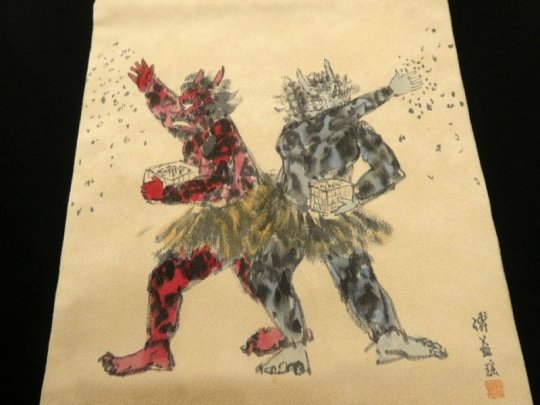
Happy Setsubun everyone!
Setsubun is a coming of Spring festival celebrated each 3rd of February with rituals meant to drive evil away. One of them is the mamemaki - throwing soybeans at people dressed up as a red or blue oni (Japanese ogre). Chasing those “demons” out of your home leave place for good fortune and Spring to set in :)
... yes the twin oni on this obi are indeed throwing beans themselves. That’s somehow pretty cute despite their angry apparences :)
181 notes
·
View notes
Photo

Setsubun Tradition: Mamemaki (Bean-Throwing)
On Setsubun, when evil spirits roam the streets and knock on your door, it’s time for desperate measures! Fill a Japanese cup called a masu with fortune beans (roasted soybeans). With the cup in your strong arm, bend your knees into a ready position. Ask the bravest family member to open the door on your count. 1, 2, 3, go!
The moment that door rushes open, pushed by the force of a winter gale, with an evil spirit riding on that invisible wave, that’s when you give it a mouthful of beans. Toss that cup of roasted soybeans out through the door while screaming, “Oni wa soto! Fuku wa uchi!” (“Demons, out! Good Fortune, in!”, 鬼は外! 福は内!). As you lunge forward into that demon-tainted wind, the beans clearing your path to safety, catch the side of the door and slam it shut! Fall to the floor, with your back securing the door, and whisper under an exhausted and exhilarated breath, “Oni wa soto. Fuku wa uchi.” Mission accomplished.
Many Japanese on Setsubun prefer instead to have a more tangible target for Mamemaki, to make certain they hit their mark and ward off bad luck for the coming season. This is where a parent courageously puts on the Oni (demon) mask and takes one for the team. Armed with fortune beans and an eagerness to break cabin fever, both spouse and children let the beans fly at the fleeing demon, chanting, “Demons, out! Good Fortune, in!”
Roasted soybeans actually serve two purposes on Setsubun. They are, of course, excellent for thwarting demons, but just as good for snacking on after all that demon-thwarting activity. After Mamemaki is successfully over, the Japanese household gathers and eats the same number of fortune beans as their age for good luck.
#Japanese Tradition#Setsubun#節分#Bean-Throwing Festival#Mamemaki#Festival#Bean Throwing Festival#Matsuri
16 notes
·
View notes
Text
Bewitching Your Coffee

I am 100% a coffee drinker. I love drinking it black, I love it in lattes and cappucini (yes, that's the actual plural of cappucino), and I especially love the experience of sharing coffee with another person. And, like everything that comes out of my kitchen, I like finding ways to make coffee more magical.
But even though coffee is a daily essential for a lot of us and has a long history in folk magic, people don't talk about it nearly as much as tea magic. I did some digging, and this post contains my research into the magic and lore of coffee and the things we like to add to coffee. I hope my fellow kitchen witches find this helpful!
Correspondences of Coffee and Common Coffee Add-ons
Coffee: Used for grounding and to anchor a spell in the physical world. Useful in spells for mental clarity and enhancing psychic senses. Used in several types of American folk magic as an offering for spirits. Author Starr Casas uses coffee for powerful cleansing and blockbusting in her Southern folk magic practice. Because of its association with energy and movement, coffee can be used to add strength to spells. I personally associate coffee with the Earth and Air elements and with the planet Uranus.
Milk has different correspondences based on whether you are using cow's milk or a plant-based milk.
Cow's Milk: Associated with nurturing, love, and abundance. In pagan Ireland, offering someone milk was an effective blessing. Milk and cream are said to be favorite offerings of fairies. I associate cow's milk with the Water element and the Moon.
Soy Milk: Soy may have been a sacred food crop in ancient China and is associated with blessings. During the Japanese festival Setsubun, soy beans are used to repel bad spirits and draw good fortune in a practice called mamemaki -- soy products can be used in spells for protection or good fortune. Use soy milk or other soy products in spells for success, good luck, and prosperity. I personally associate soy milk with the Earth element and with the planet Jupiter.
Almond Milk: Associated with prosperity, wealth, and success in business, as well as with increasing wisdom. Almond milk and other almond products are associated with the Air element and the planet Mercury.
Coconut Milk: Associated with purification, healing, and protection. In African American magic traditions, coconut can be used for peaceful home work and protection work, as well as ancestor offerings. Coconut is associated with the Water element and the moon.
Oatmilk: Associated with prosperity and money magic. Oats are associated with the Earth element and the planet Venus.
Sweeteners attract sweetness and good fortune. Different sweeteners have their own associations.
Sugar: Associated with love and lust. In Southern folk magic, sugar is sometimes used in money work. Sugar is associated with the Water element and the planet Venus.
Brown Sugar: Has the same associations as regular sugar, but works more slowly because it contains molasses.
Honey: Associated with home, family, love, and blessings. In Southern folk magic, honey is sometimes used in domination or control work, especially honeycomb. I personally associate honey with the Water element and with the planet Venus.
Maple Syrup: Associated with love, money, and long life. I personally associate maple with new life and transformation based on Robin Wall Kimmerer's writings about them in Braiding Sweetgrass. Associated with the Air element and the planet Jupiter.
Artificial Sweeteners (Splenda, xylitol, and other man-made sweeteners): There's very little written about the magical uses of these sweeteners, but I personally associate them with creativity, innovation, and new discoveries. I associate these sweeteners with the Air element and the planets Mercury and Uranus.
Caramel* is actually made from sugar, which is cooked over low heat until it caramelizes, or turns brown. Caramel has the same magical associations as sugar, but with a stronger connection to Fire energy and to transformation.
*Note: In the US, "caramel" is often made with corn syrup. For example, the caramel drizzle at Starbucks is basically 100% corn syrup, or at least was when I worked there a few years back. This isn't to say you can't work magically with corn syrup-based caramel, but the energy will be different. I don't have experience here because I have a corn allergy, so I'd love to hear if anyone has experience working with corn syrup in witchcraft!
Chocolate** is originally from Latin America and was an important ceremonial drink in Mayan culture. In Mexica (Aztec) culture, chocolate was used as currency and was said to be a gift from the gods. It was associated with the devil and with witchcraft when it was first brought to Spain by colonizers. Later, during the Renaissance, it was seen as a miracle cure for all kinds of medical conditions. Based on its history, chocolate can be used in magic for love, sex, energy, spirituality, magical abilities, and healing. I personally associate chocolate with the Fire element and with the Sun.
**Note: Scott Cunningham includes a note on "chocolate" in his book on magical herbs, but this is actually carob, Jacaranda procera. The cacao tree, which produces chocolate, is Theobroma cacao.
Cinnamon is associated with success, healing, adding power to spells, spirituality, wealth, and protection. Cinnamon is important in Christian folk magic because of its use in the Bible. In Southern folk magic, cinnamon is used for money, luck, and lust and is said to work very fast. It can also be used for blessings and protection spells. It is associated with the Fire element and the Sun.
Clove is probably most famous for its use in spells to stop gossip, but it is also used to drive away harmful spirits and to attract wealth. It is also sometimes used in love and sex magic and for successful business work. It is connected to the Fire element and the planet Jupiter.
Ginger adds power to spells and situations. It is used in spells for love, money, success, and healing, but it can be included in any spell to add power or make results happen faster. Ginger is associated with Fire and with the planet Mars.
Hazelnuts have long been used in Western European folk charms for luck and good fortune. It is said that eating hazelnuts makes you wise and can increase fertility. Hazel is also associated with protection and with granting wishes. It is connected to the Air element and the Sun.
Lavender is used in love spells, especially spells to attract a masculine partner. It also has a strong association with peacefulness and with calming emotions. It is sometimes used for protection and is said to both attract and banish spirits, depending on the source. Lavender has a long historic connection to the queer community. It is associated with Air and the planet Mercury.
Nutmeg is most famous as a good luck charm, but it is also used for healing, money, and success. In Southern folk magic, it is used mostly for money, success, and good luck. It is associated with Fire and with Jupiter.
Peppermint is commonly used in healing magic, but it can also be used for purification, attracting good spirits, divination, love, and money. In Southern folk magic, peppermint is used for hex breaking. It is associated with Fire and the planet Mercury.
Vanilla is strongly associated with love and comfort. It can sometimes be used in lust spells. Scott Cunningham mentions using vanilla to replenish lost energy. It is associated with the Water element and the planet Venus.
Magical Coffee Brews
With these ingredient correspondences, you can easily mix a spell into a coffee drink. For example, a pumpkin spice latte (which is made with pumpkin pie spice, i.e., a mix of cinnamon, ginger, nutmeg, and cloves) can be a spell for money and success. A lavender latte with oatmilk could be an excellent love spell, especially for queer love. A peppermint mocha (coffee with chocolate) could be a healing spell. There are lots of possibilities for a magic brew!
Sources:
Witchcraft for Everyone by Sam Wise
Cunningham's Encyclopedia of Magical Herbs by Scott Cunningham
Hoodoo Herbal by Starr Casas
Jambalaya by Luisah Teish
Braiding Sweetgrass by Robin Wall Kimmerer
Wikipedia article for soybeans
Wikipedia article for Setsubun
"History of Chocolate" on History.com
"Chocolate: From witchcraft to miracle worker in early modern Europe" by Erin Alice Cowling, published in The Conversation
#coffee witchcraft#coffee magic#coffee#kitchen witch#kitchen witchcraft#kitchen witchery#green witch#green witchcraft#green witchery#cozy witchcraft#cozy witch#witch#witchcraft#witchblr#spellcraft#spellwork#my writing#long post#mine
119 notes
·
View notes
Text
Hilda in Mamemaki ceremony on Setsubun
As an experienced adventurer, she can easily catch roasted beans thrown at her in the ceremony
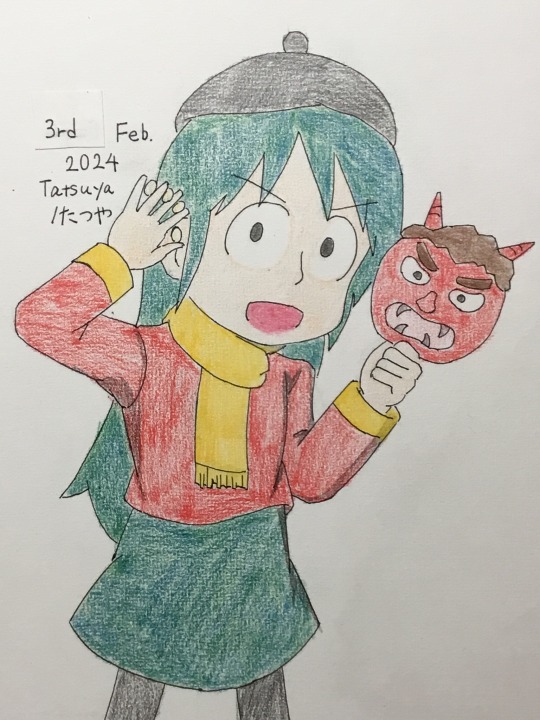
14 notes
·
View notes
Text
Devils out! Fortune in! Today is Setsubun 👹
Be gentle when throwing beans to the demon! Mike's speed is definitely going to hurt!
Setsubun is the day when Emma and her friends can be on the side of chasing or running away! Which side are you all on?
Let's get rid of evil spirits, wish for good health, and welcome the new spring!

Setsubun is the day before the beginning of spring in the old calendar in Japan. The name literally means 'seasonal division', referring to the day just before the first day of spring in the traditional calendar. In this day, we celebrate setsubun with mamemaki which mean Bean's Throwing. We throw roasted soybean (fukumame (lucky bean)) to the person who wear oni (monster) mask and yell "Oni wa soto! Fuku wa uchi!" which translated as "Devil's out! Fortune's in!".
#idv#identity v#idv official illustration#idv weeping clown#idv joker#idv acrobat#mike morton#idv mike#idv journalist#alice deross#idv alice#idv doctor#emily dyer#idv emily
8 notes
·
View notes
Text




Setsubun 2024: maiko Terutsuyo performed the dance Hime Sanja to celebrate the beginning of spring, after which Terutsuyo, Mitsuyo and geiko Ayatsuki and Umeyakko in bridal costumes joined them for the mamemaki - bean throwing ceremony
#terutsuyo#mitsuyo#ayatsuki#umeyakko#setsubun#miyajimacho#geiko#maiko#hanamachi#imvu#imvu rp#geisha rp#hanamachi rp#roleplay
3 notes
·
View notes
Text
Look i know its more merch but,, i love how they announced this one on "Setsubun" (03.02), where you try to scare and keep away demons for the oncoming year (by spilling beans "Mamemaki")


20 notes
·
View notes
Text
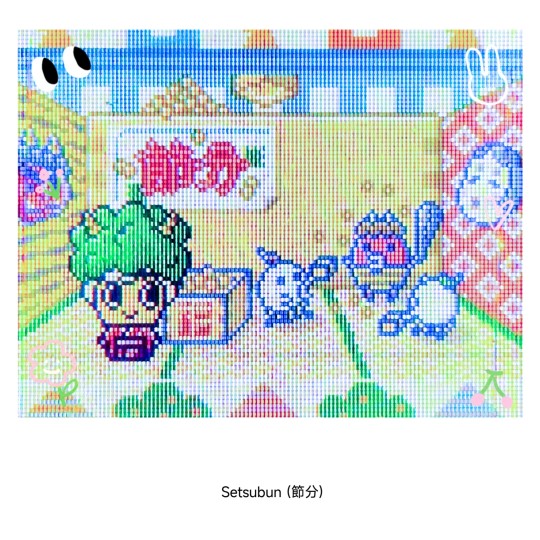
Setsubun (節分) is the day before the beginning of spring in the old calendar in Japan. The name literally means 'seasonal division', referring to the day just before the first day of spring in the traditional calendar. Setsubun is typically held on Feb 3rd.
The main ritual associated with the observance of Setsubun is mamemaki (豆撒き, 'bean scattering'); this ritual sees roasted soybeans (known as fukumame (福豆, 'fortune beans')) either thrown out of the front door, or at a member of the family wearing an oni (demon or ogre) mask while shouting 'Devils out! Fortune in!' (鬼は外! 福は内!,
#tamagotchi#たまごっち#たまごっちみーつ#bandai#tmgc#tmgccollector#tamagotchi meets#tamatag#tamagotchi mix#tamagotchi on#tamagotchiidl#tamagotchi p’s#tamapalace#tamablr
2 notes
·
View notes
Text

Today's Card Is: Mamemaki
16 notes
·
View notes
Text
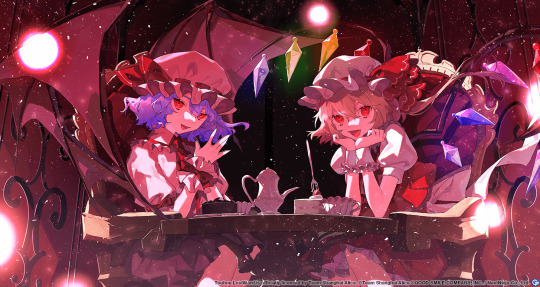
Demon Royalty | Artist: NaO
Story 1
Remilia Scarlet is the mistress of the Scarlet Devil Mansion and Flandre's older sister. She is a vampire, a bloodsucking oni, so she is weak to mamemaki… Or at least she was. She claims that she has nothing to fear from beans anymore because she ate beans to get stronger.
Story 2
Flandre Scarlet is Remilia's younger sister and a shut-in vampire. Like her sister, she isn't a fan of beans, but because she goes "Swooosh and Ka-BOOM!" to any beans that come her way, the truth is somewhat hazy.
Story 3
Setsubun is the day before the first day of spring, summer, fall, and winter. In other words, it denotes the changing of seasons. A long time ago, the first day of spring was the beginning of the year, and the day before was setsubun. The ritual of spreading beans called mamemaki was meant to exorcise evil spirits and ward against cataclysm. It is still done to this day.
Story 4
Remilia goes to Hakurei Shrine where mamemaki is occuring to see if she has grown stronger against them. Remilia has been eating not only natto but also the mysterious beans that Sakuya prepared, so she no longer has to fear beans… Or so she hopes.
Story 5
Yuugi and Suika were pelted hard by beans at the mamemaki at Hakurei Shrine. Kasen, who came on a whim, took the role of an oni in Aunn's place. It may only be mamemaki, but she couldn't bear to watch an animal being harmed, even if it is only a komainu.
5 notes
·
View notes
Photo
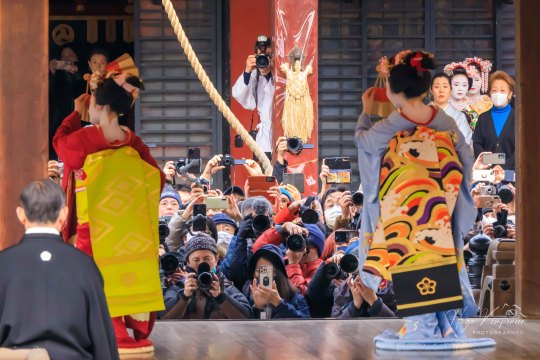
The Setsubun ceremony at Yasaka shrine differs from other Setsubun ceremonies in Kyoto. The Setsubun festival is held on the 2nd and the 3rd of February. Therefore, Geisha and Maiko from some of Kyoto’s Hanamachi districts will participate at different intervals.
#Japan#Kyoto#Pontochō kabu-kai#Risshun#Setsubun#Shinto#Yasaka Shrine#maiko#mamemaki#travel#京都#先斗町 歌舞練場#先斗町歌舞会#八坂神社#立春#節分#舞妓#豆撒き
43 notes
·
View notes
Photo
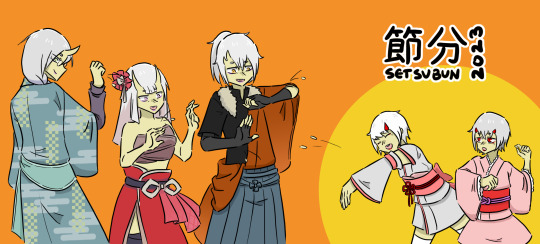
It’s nice of the adults to let the children play, but no one in Kishimura really thinks mamemaki affects them much.
#Well they aren't exactly traditional oni so that's probably why#Hey hey hey guess who made it in time for Setsubun art this year?#ME I DID IT I'm getting better at remembering dates!#Insanity Draws#Insanity of Mojiru#透明な無名世界
3 notes
·
View notes
Text
Kyoto

February 2020
Fushimi Inari Shrine is a Shinto shrine famous for its thousands of vermilion torii gates. I've been wanting to go here since forever!

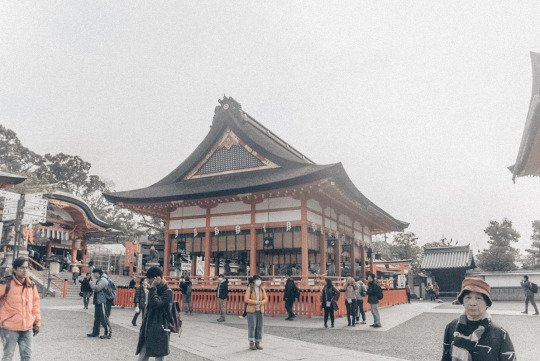

We arrived during the Setsubun Festival. They were doing mamemaki or throwing out beans in small packets to drive away evil spirits and welcome good fortune. I remember getting one.
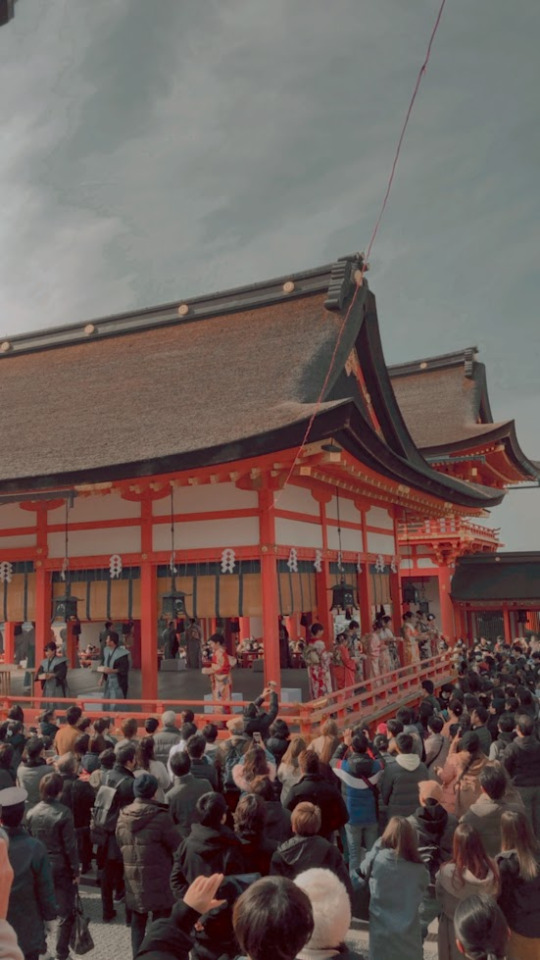
Walking through the torri gates was such a surreal and solemn experience. The birds were singing and the forest around us was humming. It was so peaceful.


I bought a Happiness Omamori (Japanese amulet) at one of the shops surrounding the area. I still carry it with me until today. 私を幸せにしてください

3 notes
·
View notes
Photo



Setsubun themed obi fabric bolt (to be tailored by shop as nagoya obi on purchased).
Setsubun is a coming of Spring festival celebrated each 3rd of February with rituals meant to drive evil away. One of them is the mamemaki - throwing soybeans at people dressed up as a red or blue oni (ogre). Chasing those “demons” out of your home leave place for good fortune to set in :)
120 notes
·
View notes
Photo
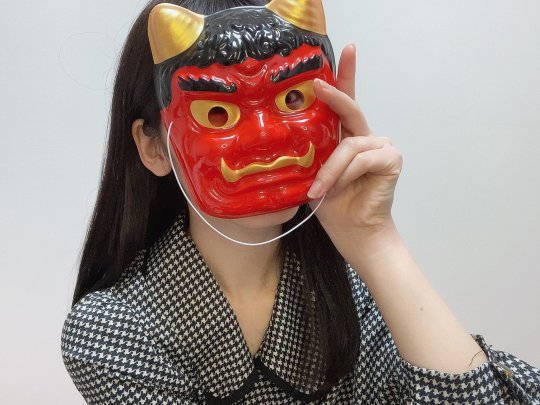
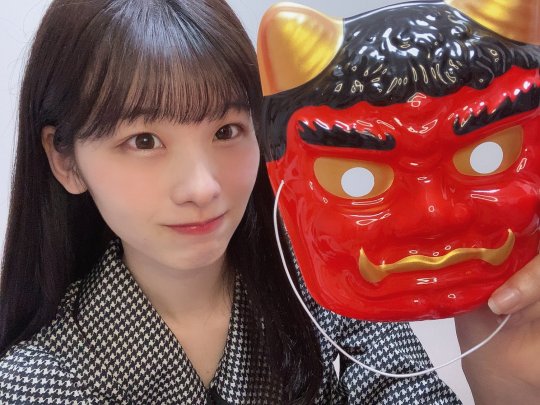
Japanese Idol, Nanami Asai wearing an Oni mask for Setsubun.
What is Setsubun?
Setsubun is celebrated on the last day of winter which usually falls on 2nd February. It’s to cleanse out the bad energy from the biting cold winter and welcome the spring season. Families will put roasted soybeans in asakemasu.
Typically, the head of the household throws these beans outside the front door, chanting, “Oni wa soto! Fuku wa uchi!” (“Demons get out! good luck come in!”). Sometimes, the father dresses like an oni (demon) and the children throw beans at him while yelling, “Oni wa soto! Fuku wa uchi!“.
This bean throwing tradition is called mamemaki, or “scattering of beans.” It’s to symbolize purifying the home from evil spirits and misfortune lingering from the previous year.
Why Beans?
In Japanese folklore, beans are symbols of good luck. Soybeans are the second favorite (after rice, of course) in the Shinto tradition. Since soybeans are bigger and slightly more intimidating than rice, they became a favorite in the Setsubun tradition to ward off demons.
More info on Setsubun here.
#japanese idol#nanami asai#oni#setsubun#asakemasu#mamemaki#japanese folklore#shinto tradition#japan#japanese culture#japanese tradition
6 notes
·
View notes